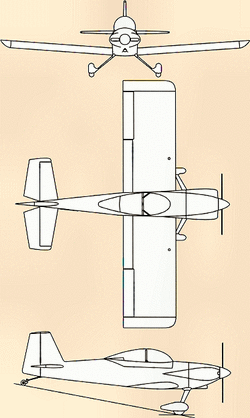Fri, Oct 13, 2023
A Mystery Half-Solved

The NTSB has released its final report on a 31 October 2021 accident in which a Vans RV4 (file photo), registration N479JJ, was destroyed and its 79-year-old Private Pilot suffered fatal injuries during a cross-country flight from Florida’s Tallahassee International Airport (TLH) to Alabama’s Monroe County Airport (MVC).
The accident-aircraft was operated as a private flight under Part 91 of the Federal Aviation Regulations.
The NTSB set forth:
“The pilot departed the airport for a cross country flight. Shortly after departure, radar services were terminated by air traffic control and the pilot was cleared for a radio frequency change. Seventeen minutes later, radar contact was lost. Automatic dependent surveillance-broadcast data obtained from the Federal Aviation Administration revealed the airplane climbed to about 2,500 ft mean sea level and made a few turns to the north and northeast before heading northwest. The airplane began to lose groundspeed, turned to the left and descended, then gained groundspeed as it continued to descend. The last data track showed the airplane at 650 ft and a groundspeed of 172 knots.
“A witness was outside at his house when the canopy from the airplane fell in his yard. The canopy was about 1.5 miles away from the main wreckage. The accident site was in a wooded area and the wreckage path was about 550 ft long. The airplane was heavily fragmented and scattered along a debris path. The canopy handle was found in the open position with the looking pin damaged and bent at its tip. It is likely that the canopy was not locked correctly before takeoff and that it opened in flight and departed the airplane.

The airplane then made a gradual slow left descending turn and continued to gain airspeed until it contacted trees and the ground at a high rate of speed. Based on the available evidence, it could not be determined if the canopy contacted and incapacitated the pilot when it separated from the airplane, which then resulted in a loss of control.”
The NTSB determined the mishap was likely caused by the pilot’s failure to properly secure the accident-aircraft’s canopy prior to takeoff—an oversight that allowed subject canopy to open in flight and separate from the RV4. While the Board concluded the canopy’s separation from the aircraft precipitated the pilot’s failure to maintain control of the airplane, investigators were unable to determine why, precisely, the aviator was rendered unable to bring the aircraft safely to ground.
Parties interested in learning more about the described occurrence should reference NTSB Accident Number ERA22FA036.
More News
Aviation Governance Secured...At Least For a While The National Business Aviation Association similarly applauded the passage of the FAA's recent reauthorization, contentedly recou>[...]
Emphasis On Growing The Future of Aviation Through Concentration on 'AFFORDABLE FLYERS' It's been a number of years since the Latest Edition of Jim Campbell's HUGE SportPlane Resou>[...]
Amazilia Aerospace GmbH, Develops Digital Flight Control, Flight Guidance And Vehicle Management Systems Textron eAviation has acquired substantially all the assets of Amazilia Aer>[...]
Honeywell's Primus Brings New Tools and Niceties for Hawker Operators Hawker 4000 business jet operators have a new installation on the table, now that the FAA has granted an STC f>[...]
Company Celebrates Niche-but-Important Advancement in Industry Standards Echodyne has announced full integration of its proprietary 'EchoFlight' radar into the e American Aerospace>[...]
 Bolen Gives Congress a Rare Thumbs-Up
Bolen Gives Congress a Rare Thumbs-Up The SportPlane Resource Guide RETURNS!!!!
The SportPlane Resource Guide RETURNS!!!! Buying Sprees Continue: Textron eAviation Takes On Amazilia Aerospace
Buying Sprees Continue: Textron eAviation Takes On Amazilia Aerospace Hawker 4000 Bizjets Gain Nav System, Data Link STC
Hawker 4000 Bizjets Gain Nav System, Data Link STC Echodyne Gets BVLOS Waiver for AiRanger Aircraft
Echodyne Gets BVLOS Waiver for AiRanger Aircraft




